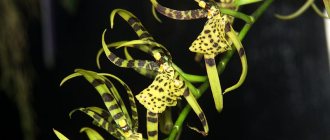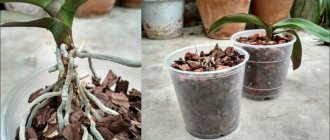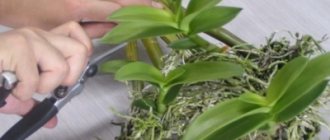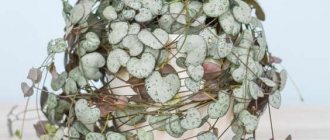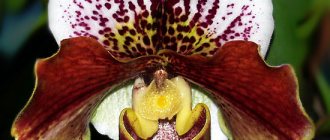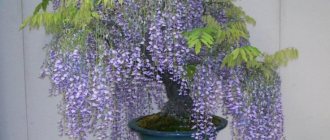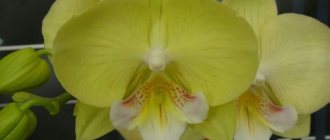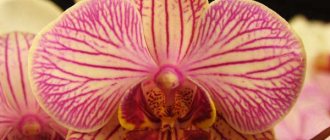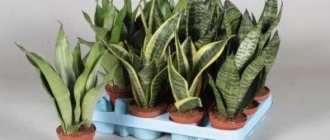In Europe, they learned about phalaenopsis at the end of the 17th century - the first plant was brought to the Old World by the German traveler Georg Rumph - he discovered this miracle of nature on the Indonesian island of Ambon, which is part of the Maluku Islands.
For more than half a century, this specimen was the only one, and only in 1752 the Swedish pastor Peter Osbeck, who was engaged in missionary work in the same Indonesia, found another orchid - on a small island. He dried it and sent the herbarium to Carl Linnaeus, who described the new species in his famous scientific work “Species of Plants.” True, he called it the lovely Epidendrum amabile. Everything is clear with the charming one, but the word “epidendrum” translated from Greek meant “on a tree,” which very accurately reflected the essence of the plant: in nature, most phalaenopsis are epiphytic plants, that is, they grow on trees.
The familiar name “phalaenopsis” came into use in 1825. It was then that the director of the State Herbarium in Leiden (Netherlands), Karl Blume, discovered, as usual, on a small island of the Malay Archipelago, another orchid from this genus. He was looking at the twilight jungle through binoculars when a flock of white butterflies caught his eye. But when he came closer, it turned out that it was an orchid. In memory of his mistake, he named the plant phalaenopsis, which in Greek means “like a moth.” That is what it is still called today.
In nature, phalaenopsis grows in the Philippines, Australia and Southeast Asia. Most often, they live on tree trunks, obtaining food from rotted organic matter in the forks of branches and cracks in trunks, and moisture from the air.
Types and varieties of phalaenopsis
The genus Phalaenopsis includes more than 70 species (1) (some botanists will identify 77 species, but 7 of them are not officially approved - perhaps they are not separate species, but clones), is divided into 5 subgenera, two of which are sections (2). Most of them live in tropical rainforests, some grow on rocks, and others live in regions with dry or cold seasons. And this leaves its mark on agricultural technology.
In floriculture, all phalaenopsis plants are usually divided into 5 groups (2).
Phalaenopsis species. This includes natural species that have not been touched by selection. As a rule, they can be found among collectors; you are unlikely to find them on general sale.
Phalaenopsis stuartiana. Its leaves are variegated and its roots are silvery. The peduncle is long and branched (up to 80 cm), but there are a lot of flowers on it - sometimes up to 60 at a time. Delicate white flowers with red spots at the base; in the center of the flower there is an amber lip, gradually turning into purple.
Schiller's Phalaenopsis (Phalaenopsis schilleriana). Its leaves are beautiful, variegated - silver spots on a dark green background, the lower part of the leaf is red. The inflorescence is up to 50 cm, and a simply gigantic number of small (up to 7 cm in diameter) flowers are formed on it. In the right conditions, this orchid blooms in a beautiful, unique cascade.
Phalaenopsis amabilis. Large white flowers up to 10 cm in diameter, about 20 flowers develop on a peduncle. The leaves are fleshy and oblong. They form a rosette of 3 to 5 leaves. Flowers bloom one by one.
Phalaenopsis lueddemanniana. A beautiful orchid with hard paired leaves up to 25 cm long. Usually there are no more than 8 of them in a rosette. The flowers are white, like porcelain, with transverse stripes of violet, purple and chestnut shades. It smells very strong and pleasant!
Phalaenopsis cornu-cervi. Very impressive look. Its leaves are green, up to 22 cm long. The flowers are collected in peduncles of 12 flowers with a diameter of up to 4 cm, and they are of a very unusual color: yellow-green with red-brown transverse stripes. Moreover, they are also fragrant.
Phalaenopsis Stewart. Photo: pixabay.com
Phalaenopsis Schiller. Photo: pixabay.com
Phalaenopsis staghorn. Photo: pixabay.com
Large-flowered hybrids. This is a very large group; it is these phalaenopsis that are most often sold in garden centers. Neither are very unpretentious, even beginners can easily grow them.
There are a huge number of varieties in this group, which are usually divided according to flower color. In our stores, they usually do not indicate the names of the varieties; more often they write “mix” on the price tags, so Russian transcription has not come into practice. So here are their international names (if you search on the Internet, you may be able to determine which variety grows in your country).
White:
- Taisuco Crane;
- Taisuco Kochdian;
- Cygnus;
- Yukimai;
- Sogo Musadian;
- White Dream;
- Florida Snow.
Pink:
- Nobby's Pink Lady;
- Minho Valentine;
- Minho King Beauty;
- New Cinderella;
- Taisuco Firebird;
- Sogo Smith.
Semi-white (their upper and side petals are white, and their lips are colored):
- Lucia Lip;
- City Girl.
Striped:
- Sogo Zebra;
- Chih Shang Stripes;
- Okay Seven.
Spotted:
- Carmela Spots;
- Rousserole;
- Soroa Delight;
- Leopard Prince.
White phalaenopsis variety. Photo: pixabay.com
Semi-white phalaenopsis variety. Photo: pixabay.com
Variety of striped phalaenopsis. Photo: pixabay.com
Variety of spotted phalaenopsis. Photo: pixabay.com
New hybrids. For a long time, phalaenopsis were on sale exclusively in white and pink shades. However, now you can find yellow, orange, and red ones in garden centers. Such colors in industrial varieties appeared relatively recently - they began to be produced about 40 years ago. And some of them have become quite popular and can be found in our garden centers.
Yellow:
- Carol Campbell;
- Emil Giles;
- Brother Lawrence;
- Taipei Gold;
- Golden Bells;
- Sogo Manager;
- Brother Passat;
- Golden Amboin;
- Yellow Queen;
- Ching Her Buddha;
- Golden Sun
Orange (there are many shades here: copper, bronze, rusty red - these shades are often called desert or artistic):
- Sweet Memory;
- Zuma Aussie Delight;
- Pago Pago;
- Brother Sara Gold.
Reds (shades here range from orange-red to lavender-burgundy):
- Cordova;
- Lonnie Morris;
- Sogo Pony;
- Sogo Rose;
- Sogo Grape;
- Sogo Prince;
- Golden Peaker.
Harlequins. This is a completely new line that appeared in Taiwan - the flowers of these phalaenopsis are white or yellow with large almost black, like ink spots, which are randomly scattered across the petals.
The most famous varieties:
- Ever-Spring Light;
- Yu Pin Pearl;
- Yu Pin Panda;
- Bright Peacock.
Multi-flowered hybrids (multiflora). This group includes phalaenopsis with many flowers, which are located either on several peduncles or on one branched one.
Popular varieties:
- Be Glad;
- Cassandra;
- Vilind;
- Carmela;
- Zuma,
- Timothy Christopher;
- Be Tris;
- Quevedo.
Miniature hybrids. This is a relatively new line that was created by crossing various miniature Phalaenopsis species. And it is in this group that the most whimsical orchids are found, because their ancestors in the wild did not live in tropical forests, but in cool or dry regions. They have a dormant period, they need cooler growing conditions, in general - this is for experienced gardeners; it is better for beginners not to start them.
The most famous varieties in this group:
- Micro Nova;
- Mini Mark
- Anna-Larati Soekardi.
Natural hybrids
- Phalaenopsis
×
amphitrite
Kraenzl.
( P. sanderiana
×
P. stuartiana
; Mindanao, Philippines) - Phalaenopsis
×
gersenia
(
P. sumatrana
×
P. violacea
; Borneo and Sumatra) - Phalaenopsis hieroglyphica
×
Lueddemanniana
(
P. hieroglyphica
×
P. lueddemanniana
; Philippines) - Phalaenopsis
×
intermedius
Lindl.
( P. aphrodite
×
P. equestris
; Leyte star; Leyte, Philippines) (First recognition of
Phalaenopsis
hybridus)
Phalaenopsis
×
intermedia
var.
Diezii
(
P. aphrodite
×
P. equestris
; Leyte star; Leyte, Philippines)
×
leucorrhoea
Rchb.f.
( P. aphrodite
×
P. schilleriana
; Luzon, Philippines)
×
Rolfeana
H. R. Sweet
×
Rothschildiana
(
P. amabilis
×
P. schilleriana
; Luzon, Philippines)
×
Schilleriano-Stuartiana
(
P. schilleriana
×
P. stuartiana
; Leyte, Philippines)
×
singuliflora
(
P. bellina
×
P. sumatrana
; Borneo)
×
Valentines
Rchb.f.
×
Veitchiana
(
P. equestris
×
P. schilleriana
; Luzon and Leyte, Philippines)
flower composition
Caring for phalaenopsis at home
Phalaenopsis are considered the most unpretentious of orchids, however, there are many nuances in their cultivation.
Priming
This is where novice gardeners usually get their first surprise: phalaenopsis should never be planted in ordinary soil! In nature, they do not encounter it, since they live in trees (some species live on rocks). Therefore, the substrate for them must be special.
The simplest option is finely chopped pine bark. Larch is even better - it is more durable. But such a substrate dries out very quickly, so it is recommended to add sphagnum moss to it in a 1:1 ratio - it retains water for a long time, and also has bactericidal properties and protects the roots from rotting.
Bark and moss can be purchased at the store. Or collect it in the forest, but in this case all the ingredients need to be boiled, because they may contain pests and pathogens.
There is another option for planting - on a piece of bark (this, of course, also needs to be boiled). In this case, the phalaenopsis is attached to the bark with wire, and the roots are wrapped in moss. Or they don’t wrap it, but in this case the orchid will have to be sprayed several times a day.
Temperature
Ideal temperature for growing phalaenopsis (2):
- during the day – 23 – 29 °C;
- at night – 18 °C.
That is, ordinary room temperature is quite suitable for him. For good growth. But not for flowering - for phalaenopsis to bloom, you need to keep it in cool conditions for at least 2 weeks, with a temperature of 13 - 15 ° C. Such conditions occur on a glazed balcony in September - send an orchid there for a couple of weeks and it will produce flower shoots.
But during flowering the temperature should be consistently warm, around 25 °C. If there are sudden changes, the phalaenopsis will drop its buds.
Lighting
Since in nature orchids are found in the eternal penumbra of huge trees, but at the same time in fairly sunny subtropics, the window sill should be light, but without direct sunlight, which can burn delicate plants. Moreover, orchids are one of those flowers that get used to their place and do not tolerate moving or even moving to another window sill quite well.
Humidity
Tropical forests have the same humidity almost all year round - 100%. In city apartments, especially in the cold season, when the heating is turned on, it barely reaches 25%. This is not enough, so phalaenopsis need to be sprayed often, but this must be done in the morning so that the leaves dry out by night. Or place trays of water nearby.
But you need to skillfully moisten the substrate: between waterings it must dry completely (2). Under no circumstances should the roots be constantly exposed to dampness - they will rot. Therefore, after watering, the water must be drained from the pan.
Fertilizers
For phalaenopsis, it is best to use special fertilizers for orchids - they are sold in stores.
Feeding
During the period of active growth, usually from April to September, phalaenopsis needs to be fed every 2 weeks. In warm weather - in the doses indicated in the instructions. But if the room is cool and it’s cloudy outside, then the norm should be halved (2).
Recommendations
- ^ a b c
"
Phalaenopsis
".
World Checklist of Selected Plant Families (WCSP)
. Royal Botanic Gardens, Kew. - ^ a b
Jones, David L. (2006).
A complete guide to the orchids of Australia, including the island territories.
. Frenchs Forest, NSW: New Holland. item 440. ISBN 978-1877069123. - Chen, Xinqi; Wood, Geoffrey James. " Phalaenopsis
". Flora of China. Retrieved December 26, 2022. - " Phalaenopsis
". Trin keys. Retrieved December 26, 2022. - "Genus Phalaenopsis
". Orchids of New Guinea. Retrieved December 26, 2022. - "Phalaenopsis Page". Online Encyclopedia of Orchid Species
. Jay Pfahl. Retrieved June 29, 2013. - Blum, Karl Ludwig (1825). Bijdragen Tot de Flora van Nederlandsch Indië (Part 7)
. Batavia. item 294. Received December 26, 2022. - ^ a b
Brown, Roland Wilbur (1956).
Composition of scientific words
. Washington, DC: Smithsonian Institution Press. - Coombs, Allen J. (1994). Dictionary of plant names
. London: Hamlyn Books. ISBN 978-0-600-58187-1. item 140 - "Alphabetical list of standard abbreviations of all generic names currently used in the registration of orchid hybrids as of December 31, 2007." (PDF). Royal Horticultural Society.
- Checklist of selected Kew World plant families
- Flora of China v 25 p 448, 羽唇兰属 yu chun lan shu, Ornithochilus
(Wallich ex Lindley) Bentham & JD Hooker, Gen. Pl. 3: 478, 581. 1883. - Wouter G. van Doorn (October 2005). "Programmed plant cell death and the point of no return." Trends in crop production
.
10
(10): 478–483. doi:10.1016/j.tplants.2005.08.003. PMID 16153879. - Mohammad Babar Ali, Serida Khatun, Eun-Joo Han, and Ki-Yeope Baek, 2006. “Increased levels of phenylpropanoid enzymes and lignin in Phalaenopsis orchid and their effects on plant acclimation under different levels of photosynthetic photon flux.” Plant Growth Regulation
volume 49, numbers 2-3, pages 137-146, doi:10.1007/s10725-006-9003-z - Stockton, Josh (20 January 2013). "A Complete Guide to the Care of Phalaenopsis Orchids." Orchids Plus. Retrieved September 19, 2020.
- "How to Care for Orchids: A Comprehensive Organic Guide."
- Conditions for growing phalaenopsis orchids, accessed November 11, 2012. Archived 2013-01-14 on the Wayback Machine
- Blanchard, Matthew G; Runkle, Eric S (2006). "Temperature during the day, but not at night, controls the flowering of phalaenopsis orchids." Journal of Experimental Botany
.
57
(15):4043–4050. Doi:10.1093/jxb/erl176. PMID 17075080. - Wang, Yin-Dong; Konow, Elise A. (2002). "Fertilizer source and average composition influence vegetative growth and mineral nutrition of hybrid butterfly orchid." American Society of Horticultural Sciences
.
127
(3):442–447. Doi:10.21273/JASHS.127.3.442. Retrieved April 29, 2020.
- Seon Kim; Clifford W. Morden; Yoneo Sagawa and Jae-Young Kim (2003). "Phylogeny of Phalaenopsis Species". Proceedings of NIOC2003, Nagoya, Japan
. - Olaf Gruss and Manfred Wolf - Phalaenopsis; Edition Ulmer, ISBN 3-8001-6551-1 (in German)
- Eric A. Christenson - Phalaenopsis: Monograph; ISBN 0-88192-494-6
- Harper, Tom (February 2004). Phalaenopsis culture: tips for growing 20 species. Orchid Journal
73(2). Delray Beach, FL: American Orchid Society, 2004. - Leroy-Terquem, Gerald and Jean Parisot. 1991 Orchids: care and cultivation.
London: Cassel Publishers Ltd. - Shozer, Gustav. 1993. Basics of growing orchids.
New York: Sterling Publishing Co., Inc. - White, Judy. 1996. Taylor's Guide to Orchids.
Frances Tenenbaum, series editor. New York: Houghton Mifflin, ISBN 0395677262
Reproduction of phalaenopsis at home
At home, 3 methods of propagating phalaenopsis are usually used.
Children. They may themselves appear on peduncles after flowering (in addition to flower buds, they also have dormant vegetative buds), but this happens extremely rarely. If you are lucky, you need to wait until their roots grow to 2 cm, separate them from the peduncle and transplant them into a new pot.
Flower arrow. For some gardeners, this method gives very good results - almost all dormant buds wake up. For others, the result is zero, but in any case it’s worth a try.
The essence of the method is this. After the phalaenopsis has faded, the peduncle is cut off at the base, treated with Epin and placed in a plastic bottle. There is no need to cut it - the neck should remain. Water is poured into a bottle up to half the length of the cutting, and a drop of fertilizer for orchids is added to it. The container is placed in a warm (preferably the temperature is 29 - 30 ° C), well-lit place (but not in direct sun). There is no need to cap the bottle.
There will always be high humidity in the bottle, and in combination with high temperature there is a chance that the buds will wake up and produce new orchids.
Pieces of peduncle. In this case, the cut flower stalks are cut into several parts, so that each one contains a dormant bud. The cuts must be thoroughly dusted with crushed charcoal (or activated) so that they do not rot.
The cuttings are placed in a transparent plastic container on damp sphagnum moss, sprayed with Epin and covered with a lid. It is important that the moss is kept moist at all times. And you need to frequently ventilate the improvised greenhouse so that mold does not appear there.
The cuttings should be kept in a bright place at a temperature above 25 °C.
Stimulation of the kidneys with cytokine paste. In this case, the children are grown on a peduncle without cutting it from the mother plant.
The point is this. You need to find a dormant bud on the peduncle, make a small incision under it on the peduncle with a sharp blade, then carefully remove the covering scales from the bud with tweezers and spread it with cytokine paste (it can be found in online stores) - they stimulate bud germination. To be safe, the bud should be wrapped in moss and polyethylene to prevent it from drying out.
Usually, after such treatment, the kidneys wake up on the 7th - 10th day. Once this has happened, the polyethylene and moss can be removed. When the children have roots, plant them in separate pots.
Transplanting phalaenopsis at home
Phalaenopsis grow aerial roots directly on top of the pot, so the size of the container is not important to them. These orchids are replanted when the substrate begins to decompose - if, when watering, small particles of bark begin to wash out of the drainage holes, then it’s time. As a rule, this happens after 2 - 3 years.
It is better to replant in the spring after the phalaenopsis has flowered. The substrate must be taken completely new, the old one cannot be used (diseases can lurk in it).
Thoroughly clean the roots from soil residues, inspect them thoroughly, remove damaged ones (dark, dried, rotten, yellowed). Treat the cuts with crushed coal.
Place the orchid in a pot (you can use an old one, but it needs to be disinfected), straighten the roots and carefully fill all the voids with substrate, but not tightly so that the roots can breathe.
Bloom
Flowers are the main advantage of an orchid. Phalaenopsis is capable of blooming often, abundantly and very beautifully.
The long-awaited appearance of the peduncle
The fact that the phalaenopsis is ready to bloom is indicated by the peduncle that appears between the axils of the leaves. The speed of its growth depends on the lighting: the more light, the faster it will form. The plant does not require additional care during this period; leave the temperature and watering the same.
You can feed the orchid until the first bud appears, but it is not necessary. Contrary to popular belief, this will not affect the number of colors. The peduncle that has barely appeared already contains the number of buds that should appear on it.
Important! As soon as the peduncle appears in the leaf axil, bring the orchid’s maintenance conditions closer to ideal. Due to dry air, lack of light, too frequent or infrequent watering, the stem may dry out and fall off.
The orchid blooms for several months. On most types of phalaenopsis, the buds open sequentially and also die.
Care after flowering
After the last flower has flown around, do not rush to trim the peduncle. Perhaps the orchid will delight you with repeated flowering. After a few weeks, the stem may begin to grow again and produce new buds.
Once flowering is complete, allow the orchid to rest. To do this, reduce the temperature in the room, reduce the amount of watering and do not apply fertilizers. If the plant needs replanting, then this is the right time.
Phalaenopsis diseases
The capricious guest of the subtropics can get sick if you care for her incorrectly.
Brown spotting. It usually affects orchid flowers - brown or pink specks appear on the petals (3). The disease does not affect other parts of the plant. Grows in damp and cool conditions.
To combat the disease, the drugs Rakurs or Topsin-M are used (4).
Bacterial brown spot. It starts as small, dirty green, watery spots on the leaves. As the disease progresses, the spots become larger and their color changes to brown. On phalaenopsis, this disease develops very quickly and soon affects the growth point (3), after which the plant may die.
If the lesions are small, the affected areas should be cut out to healthy tissue and sprinkled with coal dust. And then treat the plants with Rakurs or Topsin-M (4).
Rust. It appears on the leaves in the form of spots, which very quickly become covered with an orange coating of spores of the pathogenic fungus. This disease usually does not lead to death, but the plants are severely retarded in development and bloom poorly.
To combat this pathogen, the drugs Ikarus, Pharaoh, Falcon, and Chistotsvet are used (4).
Intergeneric hybrids
The following nothogenera have been established for intergeneric hybrids including Phalaenopsis
like ancestors.
- × Aeridopsis
(
Aerides
×
Phalaenopsis
) - × Arachnopsis
(
Arachnis
×
Phalaenopsis
) - × Asconopsis
(
Ascocentrum
×
Phalaenopsis
) - × Beardara
(
Ascocentrum
×
Dorit
×
Phalaenopsis
) - × Bogardara
(
Ascocentrum
×
Phalaenopsis
×
Vanda
×
Vandopsis
) - × Bokchoonara
(
Arachnis
×
Ascocentrum
×
Phalaenopsis
×
Vanda
) - × Cleizonopsis
(
Cleisocentron
× Phalaenopsis) - × Devereuxara
(
Ascocentrum
×
Phalaenopsis
×
Vanda
) - × Diplonopsis
(
Diploprora
×
Phalaenopsis
)
Pink phalaenopsis (moth) orchids
- × Doriellaopsis
(
Dorit
×
Kingiella
×
Phalaenopsis
) - × Doritaenopsis
(
Dorit
×
Phalaenopsis
) - × Dresslerara
(
Ascoglossum
×
Phalaenopsis
×
Renanthera
) - × Edeara
(
Arachnis
×
Phalaenopsis
×
Renanthera
×
Vandopsis
) - × Ernestara
(
Phalaenopsis
×
Renanthera
×
Vandopsis
) - × Eurynopsis
(
Eurychona
×
Phalaenopsis
) - × Hagerara
(
Dorit
×
Phalaenopsis
×
Vanda
) - × Hausermannara
(
Dorit
×
Phalaenopsis
×
Vandopsis
) - × Himoriara
(
Ascocentrum
×
Phalaenopsis
×
Rhynhostilis
×
Vanda
) - × Isaoara
(
Aerangis
×
Ascocentrum
×
Phalaenopsis
×
Vanda
) - × Laycockara
(
Arachnis
×
Phalaenopsis
×
Vandopsis
) - × Likhtara
(
Dorit
×
Gastrochilus
×
Phalaenopsis
) - × Luinopsis
(
Louisia
×
Phalaenopsis
) - × Lutherara
(
Phalaenopsis
×
Renanthera
×
Rhynhostilis
) - × Machekara
(
Arachnis
×
Phalaenopsis
×
Renanthera
×
Vanda
×
Vandopsis
) - × Meechaiara
(
Ascocentrum
×
Dorit
×
Phalaenopsis
×
Rhynhostilis
×
Vanda
) - × Moirara
(
Phalaenopsis
×
Renanthera
×
Vanda
) - × Nakagavaara
(
Aerides
×
Dorit
×
Phalaenopsis
) - × Owensara
(
Dorit
×
Phalaenopsis
×
Renanthera
) - × Parnathara
(
Aerides
×
Arachnis
×
Phalaenopsis
) - × Paulara
(
Ascocentra
×
Dorit
×
Phalaenopsis
×
Renanthera
×
Vanda
) - × Pepeara
(
Ascocentrum
×
Dorit
×
Phalaenopsis
×
Renanthera
) - × Phalaerianda
(
Aerides
×
Phalaenopsis
×
Vanda
) - × Phalandopsis
(
Phalaenopsis
×
Vandopsis
) - × Phalanetia
(
Neophynetia
×
Phalaenopsis
) - × Faliella
(
Kingiella
×
Phalaenopsis
) - × Phalphalaenopsis
(
Phalaenopsis
×
Paraphalaenopsis
) - × Puleara
(
Ascocentrum
×
Ascoglossum
×
Phalaenopsis
×
Renanthera
) - × Renanthopsis
(
Phalaenopsis
×
Renanthera
) - × Rhynchonopsis
(
Phalaenopsis
×
Rhynchostilis
) - × Rhindoropsis
(
Dorit
×
Phalaenopsis
×
Rhynhostilis
) - × Richardmizutaara
(
Ascocentrum
×
Phalaenopsis
×
Vandopsis
) - × Roseara
(
Dorit
×
Kingiella
×
Phalaenopsis
×
Renanthera
) - × Sappanara
(
Arachnis
×
Phalaenopsis
×
Renanthera
) - × Sarconopsis
(
Phalaenopsis
×
Sarcochilus
) - × Sidranara
(
Ascocentrum
×
Phalaenopsis
×
Renanthera
) - × Sladeara
(
Dorit
×
Phalaenopsis
×
Sarcochilus
) - × Stamariaara
(
Ascocentrum
×
Phalaenopsis
×
Renanthera
×
Vanda
) - × Sutingara
(
Arachnis
×
Ascocentrum
×
Phalaenopsis
×
Vanda
×
Vandopsis
) - × Trautara
(
Dorit
×
Louisia
×
Phalaenopsis
) - × Trevorara
(
Arachnis
×
Phalaenopsis
×
Vanda
) - × Trichonopsis
(
Phalaenopsis
×
Trichoglottis
) - × Aptonara
(
Phalaenopsis
×
Rhynchostilis
×
Sarcochilus
) - × Vandaenopsis
(
Phalaenopsis
×
Vanda
) - × Vandewegheara
(
Ascocentrum
×
Dorit
×
Phalaenopsis
×
Vanda
) - × Yapara
(
Phalaenopsis
×
Rhynhostilis
×
Vanda
) - × Yeepengara
(
Aerides
×
Phalaenopsis
×
Rhynhostilis
×
Vanda
)
Phalaenopsis pests
Spider mite. It usually affects the leaves and buds of phalaenopsis plants (3). Hidden on the leaves on the underside. The first signs of the disease are numerous light spots on the leaves. Then webs appear on them.
To combat this pest, the drugs Kleschevit and Fitoverm are used (4).
Flat red tick. It affects many types of orchids, including phalaenopsis. Damaged leaves become gnarled, thickened, and covered with a silvery coating (3). When heavily infested, they dry out.
Thrips. Very small agile insects with narrow bodies. The leaves are affected - characteristic silvery dotted lines appear on them (3).
To combat thrips, the drug Actellik is used.
Scale insects and false scale insects. These are small insects covered with a durable shell. They settle on all common plants, but especially like to hide in the axils of leaves (3).
Pests are removed with a cotton swab soaked in alcohol. Then the plant is washed with soapy water. The remains of scale insects are destroyed with the drug Actellik.
Mealybugs. They infect leaves, and they can be recognized by waxy secretions that look like lumps of cotton wool.
Affected plants should be washed in the shower with soap. Then spray with Aktara or Actellik (3). After 2 weeks, repeat the treatment.
external reference
| Wikimedia Commons has media related to Phalaenopsis . |
| Wikispecies has information related to Phalaenopsis |
- Phalaenopsis
orchids: species and primary hybrids - Phalaenopsis
orchid care instructions - Phalaenopsis in Kerli
| Taxon identifiers |
|
Popular questions and answers
We talked about the problems of growing phalaenopsis with agronomist-breeder Svetlana Mikhailova.
How to choose phalaenopsis?
The leaves should be a healthy color, without dried out tips, fleshy, with a waxy sheen. The aerial roots are healthy, powerful, without signs of dryness, not rotten. They sit tightly in the substrate. If you move it slightly, they do not dangle sluggishly, but hold tightly to the substrate. The flowers are tightly held on the peduncle, with a bright color, without signs of disease.
What should a pot for phalaenopsis be like?
Since the roots of phalaenopsis perform the function of photosynthesis, they must be in the light. Therefore, the pot must be transparent. You can plant these orchids in plastic pots, but they are very light. And given that the substrate is airy, there is a high risk that the plant will tip over. Glass pots are more reliable in this regard.
Why do phalaenopsis leaves turn yellow?
Leaves turn yellow when the temperature is incorrect (usually too low), lack of light or moisture.
Why do spots appear on the leaves of phalaenopsis?
This could be sunburn if the plant was sprayed with water and it was exposed to the sun's rays. But most often it is a sign of disease or pests.
Description history
Phalaenopsis was first discovered on the island of Ambon (Moluccas) by the German traveler and naturalist Georg Rumph (1627-1702).
In 1752, the Swedish pastor Peter Osbeck found another plant on a small island next to the island of Ternate and sent a herbarium to Carl Linnaeus, who described it in his famous work “Plant Species” under the name Epidendrum amabile (lovely epidendrum). The word "epidendrum" translated from ancient Greek means "living on a tree."
In 1825, the director of the Leiden Botanical Garden, Karl Blume, found another plant on a small island in the Malay Archipelago.
Looking at the jungle at dusk through field binoculars, he mistook the orchids for white moths. In memory of his mistake, Blume named the genus Phalaenopsis , which means “moth-like” (phalania - “night butterfly”, opsis - “resemblance”).
People also find other names. In India, phalaenopsis is called Moon Flower , in Europe - Butterfly Orchid .
Phalaenopsis is very popular because this orchid is relatively easy to care for.
